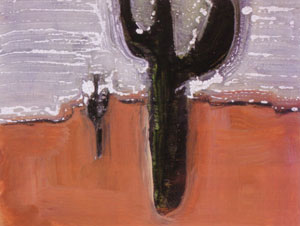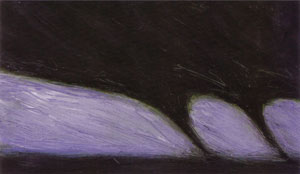Art & Antiques Review
October, 2003
Reimagining the LANDSCAPE
Contemporary American painters bring fresh ideas and techniques to a classic art form
What is it about the shape, character and look of the land that has long inspired artists to capture it for posterity on paper, canvas and even cave walls? (Archaeologists date some of the earliest depictions of animals on the land, found in caves in south-central France and in Spain, to the Paleolithic era from 35,000 to 8000 B.C.) In our time, artists in Europe and the United States have created landscapes with more than traditional aesthetics in mind. Some of their works are critical of the effects of pollution and civilization’s careless use of the earth, water and air.
Though their works may eschew momentary art-world trends, they have found keen audiences that appreciate their enduring artistic, philosophical and inspirational values. “Landscape painting will always have appeal because it connects people on a primitive level to their origins, ” says artist Don Pollack, who lives and works near Chicago. Pollack paints the American wilderness -thickets of large, heroic trees and grassy fields set against big skies; some are nocturnal scenes. However, despite his paintings’ superb realism and highly varnished, elegant presentation, viewers sense in them something on edge, something wrong. That’s when they notice the invasive electric-power lines and wire fences that cut through his classically “beautiful,” technically masterful panoramas of our post-industrial, “natural” environment. The effects of acid rain are as much on Pollack’ mind, he says, as the myths about our desire to “conquer nature” that influence how we think about the land.
Pollack’s and other artists’ works remind us that there are distinctions between what we mean by “land” and “landscape.” The former term refers to, as Milton put it in “Paradise Lost,” the actual ground onto which the Creator “spreads His orient beams on herb, tree, fruit, and flower” -that is, the physical realm surrounding the cities where “civilized” societies erect the buildings and create the institutions that are the emblems of human culture. By contrast, “landscape” refers to an aesthetic view of the unadulterated earth. It encompasses the intellectual and emotional notions with which we regard it. Generally, Western art has depicted the land in its landscapes as raw (that is, pure, unmarred by humans) and pretty.


Two paintings by Colin Cochran: “Southwest Landscape,” 2002, oil, glaze, gouache and charcoal on gessoed sandpaper, and “Double Tornado,” 1998, oil and gouache on wood panel.
For many years, painter Jane Wilson, who was born in Iowa in 1924 and moved to New York in 1949, has had a house on Long Island overlooking the water. Wilson arrived in New York when Abstract Expressionism reigned and she has painted city views and still lifes but has become known primarily for her semi-abstract landscapes. Their big skies and broad expanses of luminous color capture the nuances of the scenes she depicts. That’s because, like the 19th-century American landscape artist Martin Johnson Heade, what Wilson actually paints is the characteristic atmosphere of a place. “For me, painting still lifes means being more interested in the physicality of things and using the body to literally measure your relationship to them,” she says. “Landscape painting is about things that are physically real but more intangible.” In Wilson’s work, that means offering a fixed representation of one of nature’s most changeable forces – the weather.
The American artists Lisa Breslow and Colin Cochran also have been investigating the language of abstraction. Breslow, who grew up on Long Island, paints with washes of oil on board; out of her irregularly controlled splashes and scrapings of multiple layers of hallucinatory color, slumbering trees and the grassy banks of rivers emerge like forms coming into focus through a fog. “I grew up near the ocean,” she says. “I paint places that I have a personal relationship with — intimate scenes, not grand vistas.” That she once titled a solo show in New York “Sanctuary” says a lot about how she regards such locales.
Like Breslow, Cochran, who grew up on Cape Cod, creates images, which, as she says of her own work, “are like windows onto a place.” With an economical line and simple geometry, he crafts richly impastoed pictures of mountains, tornadoes, statuesque trees and sheep in meadows. Cochran is an experimenter: He works on wood and paper (including sandpaper) and with oil on metal or oil on ceramic tile. While Breslow’s work brings to mind Turner’s ambiguously abstract essays in saturated color, Cochran’s works sometimes recall the eerily romantic, strongly massed canvases of Albert Pinkham Ryder (1847-1917), though his palette is normally brighter than that of this early American modernist’s signature marine-themed paintings.
Contemporary landscape artists often cite such innovative abstractionists among their influences; like Breslow, Bill WestMoreland says he admires Mark Rothko’s enigmatic compositions of brooding, floating bands of color. Westmoreland was born in Arkansas and studied art in Texas before heading to New York City more than 20 years ago. His background has informed his work as a fine-art and beauty photographer and as a fashion makeup artist. He also received an MFA from Norwich University, in Vermont, in 1997. “I travel a lot, to places like Mexico, the Joshua Tree State Park in the California desert and a country house in Pennsylvania,” Westmoreland says. “I paint from memory in muted tones – grays, whites, beiges.” His renderings of rows of trees in “that space where the horizon meets the sky” are bushed, meditative and spare. The grand architectural proportions of his acrylic-on-canvas landscapes belie their often-small scale.
Valentina DuBasky also nourishes her art through travel. Among her itineraries: the legendary Silk Route from Italy to Asia. Recalling ancient cave-wall drawings and fossils and suggesting what she calls “futuristic plant forms” and an air of “magic realism,” DuBasky combines oil paint, wax and collage to conjure gardens of brightly colored forms on canvas. Metaphorically, she explains, she is “attracted to nature as a map for the human journey.” Paths figure prominently in her paintings, as do accidental marks and textures that result from her hot-wax, encaustic technique. Her pictures evoke cycles of vegetative decay and rebirth and the life-shaping passage of endless time.
Echoing other artists, Peter Edlund, a Manhattan-based painter from Connecticut, paints familiar landscape subjects – those borrowed from l9th-century Hudson River School artists are favorites – even as he subtly and critically analyzes the historical genre that they represent. For example, he repainted Frederic E. Church’s iconic “Niagara,” 1857, as a cascade of lava. In this fantastic, strangely seductive scenario, nature’s destructive, fiery forces have displaced those of a mighty river. With meticulous brushwork in the service of an oil-glazing technique that builds up layer upon layer of radiant color, Edlund examines the mythic ideas that generations of artists have brought to landscape painting as he creates his own intriguing images. “I use beauty to pull people in,” he says, “but I also want to express a sense of loss because life and much of what we see in nature is fleeting.”
Edlund’s melancholy streak is something other landscape painters might admit they share. Some are purposefully using their art to document the vulnerable natural world before concrete and asphalt are allowed to cover more of it. Others find deep satisfaction in an art form that, as Jane Wilson says, really involves us all. This veteran observer of nature’s mercurial moods and the abiding spirit of the earth, notes: “The landscape -we’re all in it all the time, but it’s one of those things we don’t think about.” Some do, of course – and with passion, too, as these artists’ works reveal. If, in their hands, meaningful landscape painting thrives, it may be because, as their art reminds us, an instinctive understanding of its power and expressiveness occupies a special place in their hearts.